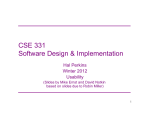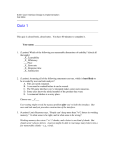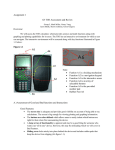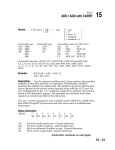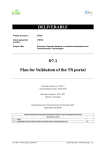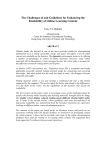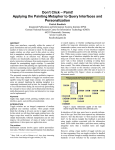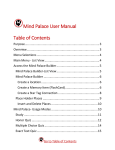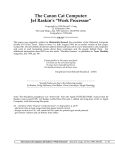Download What`s wrong? User Interface Hall of Shame Redesigning the
Transcript
What’s wrong? This lecture is FYI: the material will not be covered on the final 2 CSE 331 SOFTWARE DESIGN & IMPLEMENTATION USABILITY Usability is about creating effective user interfaces The first slide shows a WYSIWYG GUI – but it still fails – why? The long help message is needed for a simple task because the interface is bizarre! The scrollbar is used to select an award template Each position on the scrollbar represents a template, and moving the scrollbar back and forth changes the template shown Cute but bad use of a scrollbar How many templates? No indication on scrollbar How are the templates organized? No hint Much due to Rob Miller Autumn 2011 CSE 331 Autumn 2011 User Interface Hall of Shame Redesigning the Interface Source: Interface Hall of Shame 3 4 Inconsistent with common usage of scrollbars – usually used for continuous scrolling, not discrete selection How does a frequent user find a template they’ve used before? Source: Interface Hall of Shame Another for the Hall ofSource: Shame Interface Hall of Shame 5 User Interfaces Are Hard to Design 6 You are not the user Most software engineering is about communicating with other programmers UI is about communicating with users The date and time look editable but aren’t – click “Set Time” for a dialog box instead The user is always right Dialog box displays inconsistently with launch time – 12 vs. 24, analog vs. digital …but the user is not always right Click left [right] button to increase the minutes [hours] by 1 – makes a sophisticated GUI into a clock radio! Consistent Users problems are the system’s fault aren’t designers Launches housekeeping tasks at scheduled intervals 1 Iterative Design Spiral Model 7 8 UI development is an iterative process Design Evaluate Design Implement Iterations can be costly – but the benefits can be high Use throw-away prototypes and cheap evaluation for early iterations Evaluate If the design turns out to be bad, you may have to throw away most of your code Usability Defined 9 Implement Lecture Outline 10 1. Design design principles Usability: how well users can use the system Dimensions of usability Learnability: is it easy to learn? once learned, is it fast to use? Memorability: is it easy to remember what you learned? Errors: are errors few and recoverable? Satisfaction: is it enjoyable to use? Efficiency: 3. Evaluate user testing Learnability 11 2. Implement low-fidelity prototypes Metaphorical Design 12 Related to “intuitive” and “user-friendly” The first example had serious problems with learnability, especially with the scrollbar usage usage And outright inappropriate usage Unfamiliar Inconsistent Designers based it on a real-world plastic CD case Source: Interface Hall of Shame Metaphors are one way to make an interface “intuitive,” since users can make guesses about how it will work Dominated by static artwork – clicking it does nothing Why? A CD case doesn’t actually play CDs, ao the designers had to find a place for the core player controls The metaphor is dictating control layout, against all other considerations Also disregards consistency with other desktop applications. Close box? Shut it down? 2 People Don't Learn Instantly 13 Facts About Memory & Learning 14 Working memory Small: Working Memory Long-term Memory 7 ± 2 “chunks” Short-lived: gone in ~10 sec Maintenance rehearsal is required to keep it from decaying (but costs attention) Source: Interface Hall of Shame To design for learnability it helps to know how people actually learn Practically This example shows overreliance on the user’s memory It’s a modal dialog box, so the user needs to click OK But then the instructions vanish from the screen, and the user is left to struggle to remember them Just because you've said it, doesn't mean they know it infinite in size and duration rehearsal transfers chunks to long-term Elaborative memory Design Principles for Learnability Visibility 16 15 Consistency Similar things look similar, different things different Terminology, location, argument order, ... Internal, external, metaphorical Match the real world Common words, not tech jargon Source: Interface Hall of Shame Recognition, not recall Labeled buttons are better than command languages Combo boxes are better than text boxes Familiar, easy to use But passes up some tremendous opportunities, including Why only one line of display? Why not a history? Why only one memory slot? Why display “M” instead of the actual number stored in memory? Visibility also compromised by invisible modes When entering a number, pressing a digit appends it to the number; but after pressing an operator button, the next digit starts a new number – no visible feedback the low-level mode It also lets you type numbers on the keyboard, but there is no hint about this Facts About Human Perception Feedback 17 Long-term memory 18 Perceptual fusion: stimuli < 100ms apart appear fused to our perceptual systems 10 frames/sec is enough to perceive a moving picture Computer response < 100 ms feels instantaneous Color blindness: many users (~8% of all males) can't distinguish red from green normal vision red-green deficient 3 Design Principles for Visibility Efficiency 19 20 Make system state visible: keep the user informed about what's going on Mouse cursor, selection highlight, status bar Give prompt feedback – response time rules-ofthumb < 0.1 sec 0.1-1 sec 1-5 sec > 1-5 sec seems instantaneous user notices, but no feedback needed display busy cursor display progress bar Some Facts About Motor Processing 21 How quickly can an expert operate the system – input, commands, perceiving and processing output About the performance of the I/O channel between the user and the program Fewer keystrokes to do a task is usually more efficient; but it’s subtle The Gimp interface uses only contextual, cascading submenus – studies show it’s actually slower to use than a menu bar Pointing Tasks: Fitts’s Law 22 Open-loop control Senses Perceptual Cognitive Motor Muscles How long does it take to reach a target? Motor processor runs by itself Cycle time is ~ 70 ms Closed-loop control D Feedback S Muscle movements (or their effect on the world) are perceived and compared with desired result Cycle time is ~ 240 ms Moving mouse to target on screen Moving finger to key on keyboard Moving hand between keyboard and mouse Design Principles for Efficiency 23 Mode Error 24 Fitts's Law and Steering Law (constrained movement) important targets big, nearby, or at screen edges Avoid steering tasks Make Modes: states in which actions have different meanings Vi’s insert mode vs. command mode palette Drawing Reducing mode errors Provide shortcuts Eliminate Keyboard Visibility modes entirely of mode Disjoint action sets in different modes accelerators Styles Bookmarks Source: Interface Hall of Shame History 4 Design Principles for Error Handling Confirmation Dialogs: “Are you sure?” 26 25 They make common operations take two button presses rather than one Frequent confirmations dialogs lead to expert users chunking it as part of the operation Reversibility (i.e. undo) is a far better solution than confirmation – operations that are very hard to reverse may deserve confirmation, however Prevent errors as much as possible Use confirmation dialogs sparingly Support undo Good error messages Simplicity Selection is better than typing Reduce mode errors Disable illegal commands Separate risky commands from common ones Precise Speak the user’s language Constructive help Polite Source: Interface Hall of Shame Simplicity 27 28 Source: Alex Papadimoulis Design Principles for Simplicity 29 Document your system 30 “Less is More” Omit well-chosen colors and fonts with whitespace and UI metaphors functionality Not: exhaustive list of all menus Key Group Use concise language Choose labels carefully Write the user manual Program Good graphic design Few, extraneous information, graphics, features What is hard to describe? Who is your target user? Power users need a manual users might not Piecemeal online help is no substitute Casual 5 Lecture Outline Low-fidelity Prototypes 31 32 1. Design design principles Paper is a very fast and effective prototyping tool Hand-sketching is OK – even preferable 3. Evaluate user testing 2. Implement low-fidelity prototypes Paper Prototypes Use pieces to represent windows, dialogs, menus Simulate the computer’s responses by moving pieces around and writing on them Paper Prototypes 34 Paper Prototypes 35 Focus on behavior & interaction, not fonts & colors Similar to design of your data structures & algorithms Paper prototypes can even be executed 33 Sketch windows, menus, dialogs, widgets Crank out lots of designs and evaluate them User Testing 36 Start with a prototype Write up a few representative tasks Short, e.g.: Find a few representative users Three but not trivial “add this meeting to calendar”, “type this letter and print it” is often enough to find obvious problems Watch them do tasks with the prototype 6 How to Watch Users Watch for Critical Incidents 37 38 Brief the user first (being a test user is stressful) Critical incidents: events that strongly affect task performance or satisfaction Usually negative Errors Ask user to think aloud Be quiet! “I’m testing the system, not testing you” “If you have trouble, it’s the system’s fault” “Feel free to quit at any time” Ethical issues: informed consent Repeated attempts Curses Don’t help, don’t explain, don’t point out mistakes Sit on your hands if it helps Two exceptions: prod user to think aloud (“what are you thinking now?”), and move on to next task when stuck Can also be positive “Cool!” Take lots of notes “Oh, Summary now I see.” Further Reading 39 40 You are not the user Keep human capabilities and design principles in mind Iterate over your design Write documentation Make cheap, throw-away prototypes Evaluate them with users General books on usability Johnson. GUI Bloopers: Don’ts and Dos for Software Developers and Web Designers, Morgan Kaufmann, 2000. Jef Raskin, The Humane Interface, Addison-Wesley 2000. Hix & Hartson, Developing User Interfaces, Wiley 1995. Low-fidelity prototyping Usability heuristics Rettig, “Prototyping for Tiny Fingers”, CACM April 1994. Nielsen, “Heuristic Evaluation.” http://www.useit.com/papers/heuristic/ Tognazzini, “First Principles.” http://www.asktog.com/basics/firstPrinciples.html Next steps 41 Monday: UML; Wednesday: TBA A5 and A6 CSE 331 Autumn 2011 42 CSE 331 Autumn 2011 7









